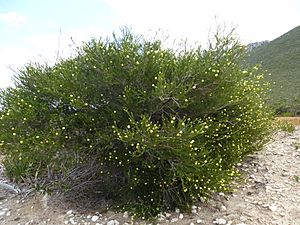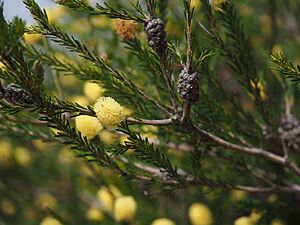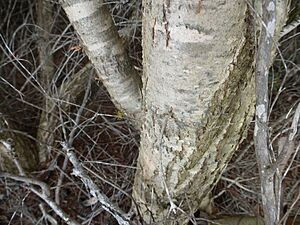Melaleuca lutea facts for kids
Quick facts for kids Melaleuca lutea |
|
|---|---|
 |
|
| Melaleuca lutea growing at East Mount Barren. | |
| Scientific classification | |
| Genus: |
Melaleuca
|
| Species: |
lutea
|
Melaleuca lutea is a type of plant that belongs to the myrtle family, called Myrtaceae. It grows only in Western Australia, which means it's endemic there. This plant is easy to spot because of its bright yellow flowers. They grow in dense, oval-shaped clusters. It also has lots of bushy leaves.
Contents
What Melaleuca lutea Looks Like
Melaleuca lutea is a shrub that stands upright. It can grow to be about 2–3 m (7–10 ft) tall. Its leaves are long and narrow, shaped like a very thin oval. Each leaf is about 5.8–24 mm (0.2–0.9 in) long and 0.8–2.1 mm (0.03–0.08 in) wide. Most of the leaves are smooth, meaning they don't have hairs. They also have a rounded, blunt tip.
Flowers and Fruit
The flowers are a bright yellow color. They grow in oval-shaped spikes. These spikes are often found at the ends of branches. The branches keep growing even after the flowers bloom. Each spike has 10 to 18 groups of flowers. These groups are packed together tightly. Each spike can be up to 25 mm (1 in) long.
Inside each flower, there are five groups of stamens. Stamens are the parts that produce pollen. Each group has 5 to 9 stamens. Melaleuca lutea usually flowers in late spring. After the flowers, the plant produces round, woody fruits. These fruits are called capsules. They are about 2–5 mm (0.08–0.2 in) long. The capsules grow in tight clusters along the stem.
Name and History
Melaleuca lutea used to be known by a different name: Melaleuca citrina. A scientist named Nikolai Turczaninow first described it in 1852.
In 2006, another scientist, Lyndley Craven, suggested a big change. He thought that all plants in the Callistemon group should be moved into the Melaleuca group. This meant that a plant called Callistemon citrinus would become Melaleuca citrina. But there was a problem! The name Melaleuca citrina was already being used for the plant we are talking about now. When two different plants have the exact same scientific name, it's called a homonym.
To fix this, the original Melaleuca citrina had to get a new name. That's why it was renamed Melaleuca lutea. The word "lutea" comes from Latin. It means "yellow," which perfectly describes the color of this plant's flowers.
Where Melaleuca lutea Grows
This melaleuca plant is found in specific areas of Western Australia. It grows in places with heath and shrubs. You can find it from the Porongurup and Stirling Range National Parks. It also grows near the Hopetoun area. These places are part of a region called the Esperance Plains. The plant prefers sandy soils on rocky hills.
Conservation Status
The Government of Western Australia's Department of Parks and Wildlife keeps track of plants. They have listed Melaleuca lutea as "not threatened." This means it's not currently in danger of disappearing.
Growing Melaleuca lutea in Gardens
Melaleuca lutea is quite popular for growing in gardens. People in Western Australia often grow it. It's known to grow well in different types of soil. When people grow it, they often still call it Melaleuca citrina, even though its official name has changed.
Images for kids
-
Habit at East Mount Barren




